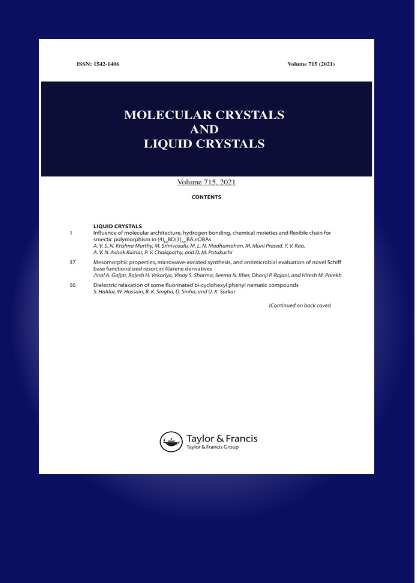Discotic liquid crystals of transition metal complexes 60 † : synthesis and π-acceptor abilities of novel discotic liquid crystals based on dithiolene nickel complex
IF 0.7
4区 化学
Q4 CHEMISTRY, MULTIDISCIPLINARY
引用次数: 0
Abstract
AbstractWe have synthesized thirteen novel metallomesogens based on dithiolene nickel complex showing π-acceptor properties: (o-C12OPhO)4DTNi (1), (m-C12OPhO)4DTNi (2), (p-C12OPhO)4DTNi (3), [o,m-(C12O)2PhO]4DTNi (4), [m,m′-(C12O)2PhO]4DTNi (5), [p,m-(CnO)2PhO]4DTNi (6: n = 10(a), 12(b), 14(c), 16(d)) and Cl-[p,m-(CnO)2PhO]4DTNi (7a–d). By using plarizing microscopic observations, differential scanning chalorimetry, and temperature-variable X-ray diffraction studies, the columnar liquid crystalline mesophases were established for the 6a–d and 7a–d derivatives. It was also revealed from the electrochemical measurements that each of the complexes of 1–7 showed good π-acceptor abilities. In particular, the derivatives, Cl-[p,m-(CnO)2PhO]4DTNi (7a–d), exhibit the most positive reduction potential from +0.08 to +0.07 V versus. SCE.Keywords: Acceptor abilitydiscotic liquid crystaldithiolne nickel complexhomeotropic alignmentmetallomesogen Disclosure statementNo potential conflict of interest was reported by the authors.过渡金属配合物的盘状液晶60†:基于二硫代镍配合物的新型盘状液晶的合成及其π受体能力
摘要以二硫代镍配合物为基础合成了13种具有π-受体性质的新型金属化合物:(o- c12opho)4DTNi(1)、(m- c12opho)4DTNi(2)、(p- c12opho)4DTNi(3)、[o,m-(C12O)2PhO]4DTNi(4)、[m,m ' -(C12O)2PhO]4DTNi(5)、[p,m-(C12O)2PhO]4DTNi (6): n = 10(a)、12(b)、14(c)、16(d)和Cl-[p,m-(CnO)2PhO]4DTNi (7a-d)。通过衍射显微镜观察、差示扫描比色法和变温x射线衍射研究,建立了6a-d和7a-d衍生物的柱状液晶中间相。电化学测试结果表明,1-7的配合物均表现出良好的π受体能力。特别是衍生物Cl-[p,m-(CnO)2PhO]4DTNi (7a-d),在+0.08 ~ +0.07 V之间表现出最大的正还原电位。南加州爱迪生公司。关键词:受体能力盘状液晶二硫镍配合物同向取向金属源披露声明作者未报道潜在利益冲突。
本文章由计算机程序翻译,如有差异,请以英文原文为准。
求助全文
约1分钟内获得全文
求助全文
来源期刊
CiteScore
1.20
自引率
14.30%
发文量
248
审稿时长
2 months
期刊介绍:
Established in 1966, Molecular Crystals and Liquid Crystals is a world-leading journal publishing original research papers in both an experimental and theoretical nature in three areas of specialization: liquid crystals, molecular crystals, and low-dimensional solids. These cover, but are not limited to:
Liquid Crystals:
-Electro- and magneto-optical phenomena; thermodynamics; phase transitions; structure; NMR and orientation-controlled spectroscopy; theory.
Molecular Crystals:
-Spectroscopy; energy and charge transfer; solid state reactions; photo and radiation effects
Low-dimensional Solids:
-Structure, electronic, magnetic, and optical properties; transport mechanisms
The journal publishes research papers, review papers, and book reviews. In all three areas, experimental manuscripts describing both preparation and properties will be considered. Papers that describe determination of crystal structure alone are not encouraged unless some solid state forces (hydrogen bonding, charge transfer, etc.) are playing a significant role and/or some solid state properties of the materials are measured.

 求助内容:
求助内容: 应助结果提醒方式:
应助结果提醒方式:


